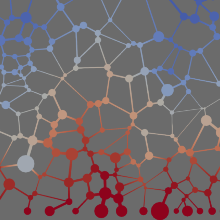We gladly pronounce the SFB 1313 paper "An efficient coupling of free flow and porous media flow using the pore-network modeling approach" by Kilian Weishaupt (SFB 1313 doctoral researcher, research project A02, University of Stuttgart) Vahid Joekar-Niasar (University of Manchester), and Rainer Helmig (spokesman of SFB 1313, principal investigator of research projects A02 and C02, University of Stuttgart). It was published in the Journal of Computational Physics: X and is a work within SFB 1313's research project A02.
Abstract
Macro-scale models of coupled free flow and flow through a permeable medium often lack the capabilities to account for process-relevant complexities on the pore scale. Direct numerical simulation of such systems, on the other hand, inherently includes these micro-scale features but is only feasible for problems of very limited spatial and temporal extent. A new class of hybrid models aims to combine the individual strengths, i.e., computational efficiency and local accuracy on the micro scale, of models of different dimensionality.
We propose, to our knowledge for the first time, a fully coupled model concept that involves a (Navier-) Stokes model for the free flow and a pore-network model for the porous domain. As a first step, we consider isothermal single-phase flow with and without component transport, but the model is open for extension for more complex physics. Appropriate coupling conditions guarantee the continuity of mass and momentum fluxes across the interface between the two domains. The coupled model is implemented in DuMu![]() , an open-source toolbox for the simulation of flow in porous media. We use a monolithic approach, i.e., all balance equations are assembled into a single system matrix and no coupling iterations between the submodels are required. Newton's method is applied to solve the potentially non-linear system of equations.
, an open-source toolbox for the simulation of flow in porous media. We use a monolithic approach, i.e., all balance equations are assembled into a single system matrix and no coupling iterations between the submodels are required. Newton's method is applied to solve the potentially non-linear system of equations.
The model is able to handle both structured and unstructured, randomly-generated networks. For the structured porous domains, the simulation results of the coupled model were compared to numerical reference solutions where excellent agreement was found, both for Reynolds numbers below one and around 400 in the free-flow channel. When applied to a geometrically complex unstructured network and considering compositional flow, clear paths of preferential flow could be identified which also locally affect the adjacent region of free flow at the respective interface. The ability to account for such pore-scale characteristics makes the model an interesting option, e.g., for simulating coupled flow problems that feature non-Fickian transport behavior or multi-phase flow, which will be investigated in future work.


